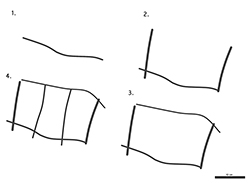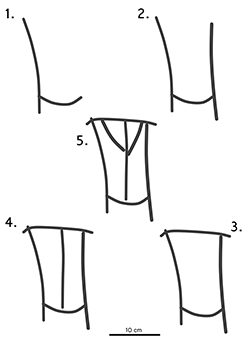

One of the noted applications of PTM to rock art analysis and interpretation is the ease of detection of superimposition within the captured motifs (Mudge et al. 2006). Close examination of Panels 4A and 7A makes it possible to document the successive creation and overlay of incisions that constitutes the finished panels, both quadrilateral engravings with internal subdivision composed of intersecting lines.
Panel 7A is shown annotated in Figure 9. Lattices and internally subdivided rectangles are a common motif at Avencal 1; this panel and 2A are composed entirely of this class of engraving. Each cut of 7A is labelled A to F for representational purposes. The insets 1 to 4 in Figure 9 display areas of superimposition of the motifs, and correspond to the numbered bookmarks that accompany the PTM datasets in the ADS archive. In this case, PTM enables the retrieval of the relative times of creation of several cuts, providing direct evidence of how a geometric engraving was made into its final state (Mudge et al. 2006). We use this information to suggest that the following sequence of engraving took place in Panel 7A: [C]-[D, B]-[A]-[E-F]. From left to right, the letters in square brackets go from first to last in the sequence of production. Groupings of letters indicate that no direct relationship can be discerned, only that these cuts were made before the remaining cuts. This is illustrated as a sketch in Figure 10. We emphasise that this is the sequence that the PTM allows us to interpret. As the engraving is being viewed in its final state, we recognise the possibility that the lines of 7A and others may have been re-engraved or 'touched up' at any point after its initial production. Our interpretation as presented here may only be one part of the story.

We repeated this procedure on a detail of a second panel, 4A (Figure 11), to demonstrate the wider applicability of such reconstructions. This engraving is composed of seven intersecting lines. We use the same notation for the exterior enclosing cuts as in Panel 7A for consistency and comparability, running counter-clockwise from the top cut A. Two cuts, D and G, are at an acute angle to the rest. Examining the superpositioning of the cuts under specular enhancement (bookmarks 1-4), a second sequence of production can be suggested: [B, C]-[D]-[A]-[F]-[E, G].

Although we find it likely that Cut B precedes Cut C, based on the observation that the former does not begin where the latter ends, the superpositioning of these is ambiguous and does not affect the interpretation of the remaining cuts. They are therefore grouped together as the first two cuts. Cuts E to G begin off the margin of Cut A. The five-step sequence of engraving for this panel is described in Figure 12.

Internet Archaeology is an open access journal based in the Department of Archaeology, University of York. Except where otherwise noted, content from this work may be used under the terms of the Creative Commons Attribution 3.0 (CC BY) Unported licence, which permits unrestricted use, distribution, and reproduction in any medium, provided that attribution to the author(s), the title of the work, the Internet Archaeology journal and the relevant URL/DOI are given.
Terms and Conditions | Legal Statements | Privacy Policy | Cookies Policy | Citing Internet Archaeology
Internet Archaeology content is preserved for the long term with the Archaeology Data Service. Help sustain and support open access publication by donating to our Open Access Archaeology Fund.
File last updated: Tue Feb 3 2015